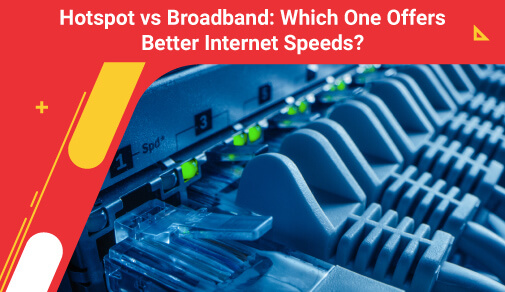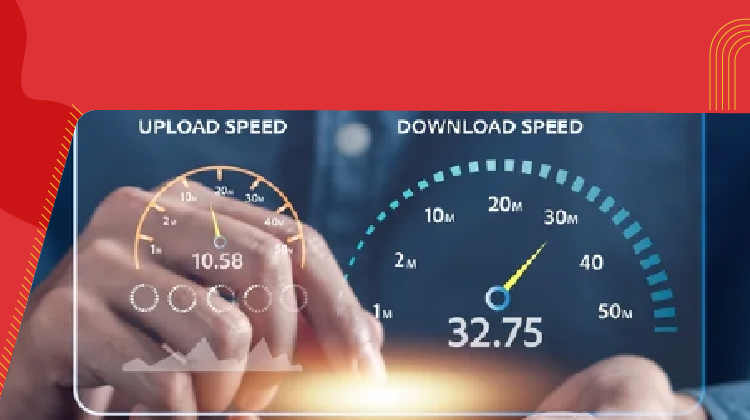Hotspot vs Broadband
Wednesday, Jun 21, 2023 · 8 minutes


HOTSPOTS
Wednesday, Jun 21, 2023 · 8 minutes
In today's fast-paced digital world, having a reliable and speedy internet connection has become more crucial than ever before. With various options available in the market, it can be challenging to determine which type of internet connection is best suited for your needs.
Two such concepts are Wi-Fi hotspots (commonly called hotspots) and broadband connections. While both offer the convenience of wireless connectivity, they have significant differences in terms of speed, reliability, and cost.
Learn more about hotspot and broadband internet services to help you understand which one is better for your needs.
Intel defines a Wi-Fi hotspot as "A physical location where people can access the Internet, typically via a wireless local area network (WLAN) with a router connected to an Internet service provider."
In simple words, a hotspot is a medium or a place where multiple users can connect their internet devices, such as laptops and mobile phones, to the internet. Wi-Fi hotspots are usually available at airports, coffee shops, restaurants, parks, and other public places. Cafes like Starbucks and McDonald's have popularised the concept of Wi-Fi hotspots in recent times.
A Wi-Fi hotspot works by broadcasting a signal over a short distance, usually about 300 feet. When users connect their device to the hotspot, it will pick up the broadcasted signal and allows them access to the internet. The internet speed offered by Wi-Fi hotspots typically ranges from 20 Mbps to around 100 Mbps.
Depending on the place, internet access in Wi-Fi hotspots is usually provided for a small fee or can even be free in some cases. Users can pay for the access with a credit card or by signing up for a membership.
Users are generally asked to enter their mobile number to get access to the internet. An OTP is then sent to the user's mobile, which needs to be entered in order to gain access. After that, they can get access to the internet for a pre-defined period of time. Usually about 30 minutes to an hour, depending on the place.
Using a Wi-Fi hotspot connection provides many advantages to users. Some of the most notable include:
. Exceptionally convenient
Wi-Fi hotspots are incredibly convenient as they can be found at almost any public place. Users can simply connect to the hotspot and get access to the internet for a nominal fee or even for free.
. Excellent Speed
The download and upload speeds provided by Wi-Fi hotspots are usually good enough to carry out day-to-day tasks such as browsing, streaming videos, and more.
· Cost-effective
Wi-Fi hotspots are usually cheaper than broadband connections and cost only a few Rupees per hour.
While Wi-Fi hotspots are great, they also have some drawbacks that need to be taken into consideration. They are:
· Security Risks
Wi-Fi hotspots can be vulnerable to cyber-attacks. As multiple people are using the same network, if one device is attacked, it could affect other users as well. It's always recommended to use the best security practices when using public Wi-Fi hotspots.
· Limited Range
Wi-Fi hotspots have a limited range, usually about 300 feet. This means that users have to stay within the range in order to get access.
A broadband connection, on the other hand, is a dedicated internet connection that comes with a much higher internet speed than Wi-Fi hotspots. Broadband connections are provided by telecom companies or Internet Service Providers (ISPs) via a physical connection to the user's premises.
Broadband connections usually use coaxial cables, optical fibres, twisted pair copper wire and other such technologies to deliver high-speed internet. Users can then plug in their devices to the modem or router and get access to the internet on multiple devices at once.
Broadband connections usually offer internet speeds ranging from 1 Mbps to around 1000 Mbps (1 Gbps). This makes them ideal for a plethora of internet activities ranging from simple web browsing to streaming high-definition videos or even playing online games.
Broadband connections provide numerous advantages:
. High Internet Speed
The internet speed provided by broadband connections is much higher than that offered by Wi-Fi hotspots. Plus, since the connection is used only by the user or their family, the entire speed is available without any disturbances.
. Reliability
Broadband connections are more reliable than Wi-Fi hotspots as they don't get affected by distance. As long as the modem or router is connected, users can get access to the internet without any interruptions.
. Availability
Broadband connections are available 24/7 unless there's an interruption in service due to maintenance or other technical issues. All the user needs to do is connect their device to the modem or router and get access to the internet.
. Security
Broadband connections offer much better security than Wi-Fi hotspots. In the case of a wired connection, it becomes much harder for hackers to intercept the signal. Similarly, when using a Wi-Fi connection, users can enable better security measures such as strong WPA2 encryption.
. Ideal for home usage
A broadband connection is the best option when it comes to home usage, as the entire family can use the connection for various internet activities. Plus, users can also take advantage of various deals and discounts provided by the ISP for long-term plans.
Some of the drawbacks of broadband connections include the following:
. Costly Setup
Broadband connections come with a setup cost that includes the cost of the modem or router, installation charges, and more. Plus, they also have to pay monthly rentals for the connection, whether they use it or not. This can be expensive for some users, especially those on a tight budget.
. Tied to a certain ISP
Broadband connections are usually tied to a certain ISP. This means that the user has to stay with the same service provider even if they're not satisfied with the services till the subscription expires.
. Limited Range
The range of broadband connections is limited to the premises they're connected to. Even if users have a Wi-Fi router, the range is still generally limited to the walls of their house. At most, the signal can reach around 100 metresin an open space.
Broadband is an umbrella term used for high-speed internet connections. It includes a variety of technologies such as cable, DSL, fibre optic and others. Some of the most common types of broadband connections include:
Cable broadband connections use the same coaxial cables that are used to deliver cable TV signals. They provide speeds of 1.5 Mbps or more and are usually available in urban areas.
Digital Subscriber Line (DSL) connections use copper telephone lines to deliver high-speed internet signals. This technology is available in many parts of the world and can provide speeds ranging from 1 Mbps to 100 Mbps or more.
Fibre optic broadband connections use fibre optic cables to deliver internet signals at high speeds. This technology is available in many parts of the world and can provide speeds up to 1 Gbps or even higher.
Broadband Over Power Lines (BPL) is a technology that uses existing power lines to deliver internet signals. This technology is still in the development phase and is not widely available. The speeds offered by BPL connections are comparable to DSL and cable modem speeds.
Users having a broadband connection need to regularly check the internet speed of their connection to ensure that they're getting the promised speeds. This broadband speed test can be done easily by using speed test tools such as Speedtest.net or Fast.com.
These tools required the user to simply open their website and click on the 'Start Test' button. The speed test usually takes a few minutes to complete and provides detailed information about the download speed, upload speed, and ping time of the connection. This helps users to have a better understanding of their connection speeds and identify any potential issues with their broadband connection.
To get the Internet speed results within seconds, the users can:
1. Go to www.speedtest.net
2. Click on the 'Go' button
3. Wait for the test to complete.
Once the test is completed, users will be able to see their download speed, upload speed, and ping time, along with other details.
Similar to Speedtest, there are other websites where users can also perform a broadband speed test. The process is similar to that of Speedtest.net, and users can choose to check the speed of their broadband connection.
Fast.com, which is owned by Netflix, also provides users with an easy-to-use interface and offers accurate results for broadband speed tests.
The process of performing a broadband speed test on Fast.com is even simpler than on Speedtest.net.
Simply go to www.fast.com. The broadband speed test will start automatically. Once the test is completed, users will be able to see their download speed and other details.
Typically, a broadband connection offers better internet speeds compared to a hotspot. This is because broadband connections are generally meant for home usage, and thus the connection is utilised by a few users. On the other hand, hotspots are wireless networks that are accessed by a large number of users. This can lead to slower speeds and higher latency, as the connection has to be shared between multiple users.
Additionally, Wi-Fi hotspots are usually exposed to a lot of interference and can be affected by other wireless networks in the vicinity. This further adds to the latency and slow speeds of a hotspot connection compared to a broadband connection.
So, in conclusion, broadband connections are generally faster than hotspots and offer better internet speeds.
Broadband connections turn out to be a better option than Wi-Fi hotspots when it comes to internet speeds. Moreover, they are also more secure and reliable. Therefore, for a faster and better internet experience, it is recommended to opt for a broadband connection instead of a Wi-Fi hotspot.
ACT provides broadband plans with speeds up to 1 Gbps so that users can enjoy a fast and reliable internet experience. Subscribe to the specially curated plans for personal as well as business users. The speed of the plans begins at 40 Mbps and can go all the way up to 1 Gbps. Additionally, users can also opt for unlimited plans that offer high speeds with no usage caps and restrictions. So, explore your options today! For more information about our broadband plans, visit our website.
102

The New Social: How High-Speed Internet is Redefining 'Quality Time' with Friends and Family
Read more398

How ACT SmartWi-Fi is Redefining Home Internet in 2025: The Age of AI-Powered Seamless Connectivity
Read more154

From Bandwidth to Intelligence: How AI Is Redefining Business Demands from ISPs
Read more
A referral link has been sent to your friend.
Once your friend completes their installation, you'll receive a notification about a 25% discount on your next bill
![]() Please wait while we redirect you
Please wait while we redirect you

![]() One of our representatives will reach out to you shortly
One of our representatives will reach out to you shortly

One of our representatives will reach out to your shortly
![]() Please wait while we redirect you
Please wait while we redirect you

Please enter your registered phone number to proceed

Please enter correct OTP to proceed


Dear customer you are successfully subscribed
Please wait while we redirect you

Your ACT Shield subscription has been successfully deactivated

Dear user, Your account doesn't have an active subscription

Dear customer Entertainment pack is already activated.
Please wait while we redirect you